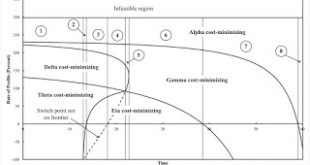I happen to think the minimum wage in the United States should be raised. I'll go along with the consensus of $15 an hour. I also happen to know that, even under ideal conditions, wages and employment cannot be explained by supply and demand. Some economists, who I no (other) reason to disrespect, seem to think my true statement about labor economics can be discredited by attacking my motivations. So they point out how, under (incoherent) neoclassical theory, higher minimum wages can...
Read More »Reswitching, Recurrence, And The Incoherence Of The Marginal Productivity Theory Of Distribution
Blair Fix argues that economists argue in a circle in putting forth the marginal productivity theory of distribution. I know that there is no such consistent theory anyways. It occurs to me that process recurrence, as well as the reswitching of techniques, can be used to demonstrate this inconsistency. Suppose you completely know the technique being used in an economy to produce its output. And, which is even more impossible, you know all other possible techniques. I am thinking of a...
Read More »Structural Economic Dynamics And Reswitching In A One-Good Model
This post, as suggested, extends this one-good example. I assume a constant returns-to-scale technology, as specified in Tables 1 and 2. Labor is advanced to the capitalists, and wages are paid out of the surplus at the end of the year (period of production). The capitalists (incorrectly) expect the technology in existence at the start of the year to continue to exist. I assume prices of (re)production prevail. Table 1: Inputs for The Technology InputProcess(I)(II)(III)Labor30 eσ0,1(1 -...
Read More »Structural Economic Dynamics, Markups, Real Wicksell Effects, And The Reverse Substitution Of Labor
I am being published in Structural Change and Economic Dynamics. Currently, this link is without my corrections to proofs, I guess. Research highlights: Technical progress and variations in industry markups can change characteristics of the labor markets. A numeric example illustrates the theory of the choice of technique. In the example, switch points are created and destroyed with varying coefficients of production and varying markups. Around some switch points, higher wages are...
Read More »No Such Thing As The Natural Rate Of Unemployment
I know that the idea of a "natural rate" of unemployment or a non-accelerating inflation rate of unemployment (NAIRU) makes no sense. I cite, for example, James Galbraith's 1998 book, Created Unequal: The Crisis in American Pay. I think Colin Rogers' 1989 book is related. Jared Bernstein gives the idea of a natural rate of unemployment at the first of four examples of ideas that [mainstream] economists have gotten wrong for decades. This is not the first example of a case where Post...
Read More »Harrod-Neutral Technical Progress and Fluke Switch Points
Figure 1: A Pattern Diagram I have put up a working paper with the post title. Abstract: This article considers Harrod-neutral technical progress in the context of an analysis of the choice of technique. In a model of the production of commodities by means of commodities, neutral technical change is compatible with the reswitching of techniques, capital reversing, process recurrence, and the reverse substitution of labor. A taxonomy of fluke switch points is applied to an example,...
Read More »Children, Dialectics, and Topology
"One of the curious things about our educational system, I would note, is that the better trained you are in a discipline, the less used to dialectical method you're likely to be. In fact, young children are very dialectical; they see everything in motion, in contradictions and transformations. We have to put an immense effort into training kids out of being dialecticians." -- David Harvey, Companion to Marx's Capital: The Complete Edition. Verso (2018). I do not have children, and I am...
Read More »On Milana’s Purported Solution To The Reswitching Paradox
Carlo Milana has posted a paper on arXiv. I was prepared to accept this paper's claims. Economists have developed price theory. Referring to Sraffian "paradoxes" and "perverse" switch points is a matter of speaking. There does not exist separate Sraffian and neoclassical versions of price theory. For a result to be "perverse", it need only contradict outdated neoclassical intuition. But it is as much a part of the mathematical economics as any other result. (It is another matter that much...
Read More »Easy To Be Hard
[embedded content]Young Children Policing Group Members This post presents examples of psychologists inducing stress in experimental subjects, some showing why we need Institutional Review Boards (IRBs). Some of the older studies involved so much suffering that experimental subjects suffered Post-Traumatic Stress Disorder (PTSD). I recall that at the end of the 1976 movie, The Tenth Level, about the Milgram experiment, starring William Shatner, the scientists are discussing what they would...
Read More »Lewin and Cachanosky on Neo-Ricardian Economics [Citation Needed]
This post is about the misrepresentation of Sraffian capital theory in Lewin and Cachanosky (2019). I cannot recommend this short book. Presumably, it is meant as an introduction. But I do not see it as succeeding. I do not see what a more advanced audience would get out of it that is not available in a few recent papers by Lewin and Cachanosky. Before proceeding to my main theme, let me note that I agree with some parts of this book, mainly where Lewin and Cachanosky draw on Ludwig...
Read More » Robert Vienneau: Thoughts Economics
Robert Vienneau: Thoughts Economics



